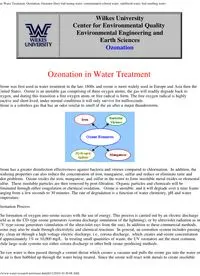
Overview of Ozonation in Water Treatment 2010 PDF
Preview Overview of Ozonation in Water Treatment 2010
Ozone Water Treatment, Ozonation, Ozonator Dirty bad tasting water, contaminated colored water, unfiltered water, bad smelling water http://www.water-research.net/ozone.htm[6/11/2010 10:20:08 AM] Wilkes University Center for Environmental Quality Environmental Engineering and Earth Sciences Ozonation Ozonation in Water Treatment Ozone was first used in water treatment in the late 1800s and ozone is more widely used in Europe and Asia then the United States. Ozone is an unstable gas comprising of three oxygen atoms, the gas will readily degrade back to oxygen, and during this transition a free oxygen atom, or free radical is form. The free oxygen radical is highly reactive and short lived, under normal conditions it will only survive for milliseconds. Ozone is a colorless gas that has an odor similar to smell of the air after a major thunderstorm. Ozone has a greater disinfection effectiveness against bacteria and viruses compared to chlorination. In addition, the oxidizing properties can also reduce the concentration of iron, manganese, sulfur and reduce or eliminate taste and odor problems. Ozone oxides the iron, manganese, and sulfur in the water to form insoluble metal oxides or elemental sulfur. These insoluble particles are then removed by post-filtration. Organic particles and chemicals will be eliminated through either coagulation or chemical oxidation. Ozone is unstable, and it will degrade over a time frame ranging from a few seconds to 30 minutes. The rate of degradation is a function of water chemistry, pH and water temperature. Ozonation Process The formation of oxygen into ozone occurs with the use of energy. This process is carried out by an electric discharge field as in the CD-type ozone generators (corona discharge simulation of the lightning), or by ultraviolet radiation as in UV-type ozone generators (simulation of the ultraviolet rays from the sun). In addition to these commercial methods, ozone may also be made through electrolytic and chemical reactions. In general, an ozonation system includes passing dry, clean air through a high voltage electric discharge, i.e., corona discharge, which creates and ozone concentration of approximately 1% or 10,000 mg/L. In treating small quantities of waste, the UV ozonators are the most common, while large-scale systems use either corona discharge or other bulk ozone-producing methods. The raw water is then passed through a venturi throat which creates a vacuum and pulls the ozone gas into the water or the air is then bubbled up through the water being treated. Since the ozone will react with metals to create insoluble Ozone Water Treatment, Ozonation, Ozonator Dirty bad tasting water, contaminated colored water, unfiltered water, bad smelling water http://www.water-research.net/ozone.htm[6/11/2010 10:20:08 AM] metal oxides, post filtration is required. Primary Advantages to Ozone 1. Ozone is effect over a wide pH range and rapidly reacts with bacteria, viruses, and protozoans and has stronger germicidal properties then chlorination. Has a very strong oxidizing power with a short reaction time. 2.The treatment process does not add chemicals to the water. 3. Ozone can eliminate a wide variety of inorganic, organic and microbiological problems and taste and odor problems. The microbiological agents include bacteria, viruses, and protozons (such as: Giardia and Cryptosporidium). Disadvantages to Ozone 1. There is a higher equipment and operational cost and it may be more difficult to find professional proficient in ozone treatment and system maintenance. 2. Ozonation provides no germicidal or disinfection residual to inhibit or prevent regrowth. 3. Ozonation by-products are still being evaluated and it is possible that some by-products by be carcinogenic. These may include brominated by-products, aldehydes, ketones, and carboxylic acids. This is one reason that the post filtration system may include an activate carbon filter. 4.System may require pretreatment for hardness reduction or the additional of polyphosphate to prevent formation of carbonate scale. 5.Ozone is less soluble in water, compared to chlorine, and therefore special mixing techniques are needed. 6.Potential fire hazards and toxicity issues associated with ozone generation. National Small Flows Clearinghouse - PDF on Ozone For More information about the Environmental Quality Center, please contact: Attn: Mr. Brian Oram, Professional Geologist (PG) Laboratory Director Wilkes University Environmental Engineering and Earth Sciences PO Box 111 84 West South Street Wilkes-Barre, PA 18766 Home | Technology Outreach Program | Drinking Water Help Guides | Contact Us Available Test Parameters Research Interests, Funded Research and Applied Research Ozone Water Treatment, Ozonation, Ozonator Dirty bad tasting water, contaminated colored water, unfiltered water, bad smelling water http://www.water-research.net/ozone.htm[6/11/2010 10:20:08 AM] Homeowner Information Water Testing Environmental Topics - Infiltration, Soils, Wellhead Protection, Groundwater, Watersheds PowerPoint Presentations Watershed Monitoring, Research, Training, Lake and Watershed Studies, Volunteer Monitoring Programs The Water Library - Pdf files on Water Issues and Topics Tools for Undergraduate Students Field Training and Workshops in Earth Science Affiliations and Hot Links | Search Our Site|
